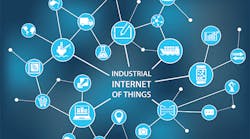Because IIoT makes networking simpler, users can devote more of their precious time and labor to linking more devices and bringing in more types of data. This is useful because, not only are there more signals from more process applications, but there are also more processes within larger applications, machines and other equipment.
For example, 76-year-old Arthur G. Russell Co. (AGR, arthurgrussell.com) in Bristol, Conn., builds and integrates large-scale, high-throughput (200-1,800 parts per minute) assembly and packaging equipment for pharmaceutical and medical device clients, but its machines typically contain multiple flow, temperature, pressure and other small process applications, such as measuring reagents down to microliter levels.
“Within our macro-sized machines are micro-processes that need flowmeters for measuring cubic feet per minute or power meters for measuring kilowatts per hour. We have continuous and discrete controls, and each station gets key process indicating variables (KPIV) that users employ to optimize their applications by exchanging data with their business systems,” explains Brian Romano, technology development director at AGR, which is a member of the Control System Integrators Association (CSIA, www.controlsys.org). AGR used to own system integrator PACsys, which began tying together production and enterprise systems in 2004-07. “A large tile grout and adhesive manufacturer wanted to let their plant-floor PLCs pull business system recipes, assign raw materials, execute processes, and let an operations-server PC send results like uptime, downtime, and product weights and numbers back to the enterprise’s SQL server database.”
To establish these initial links, Romano reports that PACsys installed an EtherNet/IP network and a local operations server PC with connectivity to the business system server. Next, it implemented Wonderware InTouch HMI software, as well as Factory PMI software from Inductive Automation before it was renamed Ignition. This solution gave anyone on the firm’s corporate network secure access to its production performance reports.
The Industrial Internet of Things is surpassing itself with added data sources, more detailed information and greater insights—if users are open-minded and flexible enough to try it. Read more of this series here.
“Users could query SQL, look at downtime events, and see a Pareto analysis about why a bagger was stopped 10 times per day and costing 35 minutes,” says Romano. “In 2007, we replicated this solution at seven of the grout company’s other plants. This was all before IIoT, but since then, operations technology (OT) and information technology (IT) got closer, and IIoT has become an accepted method of exposing data from plant-floor equipment. Ten years ago, memory and data storage cost more and power was limited, so IIoT was mostly done locally. More recently, computing power, memory and cloud storage increased, and became less expensive at the same time.”
The shift to more powerful, less costly computing allowed AGR to integrate its machines with Ethernet and network protocols, but also let it develop models and simulations based on longtime, lean manufacturing practices from its users and their plants, according to Romano. “IIoT and Industry 4.0 are applications of lean principles, such as ‘being better at what we’re doing by learning what we have.’ The difference now is, as plant floors get more integrated, every station provides more data much faster, and we need more capable software and hardware for statistical analysis, machine learning (ML) and artificial intelligence (AI) to produce more useful conclusions.”
Romano adds that AGR just launched its Industry 4.0 Smart Manufacturing Interface that employs software and hardware to coordinate data gathering and analytics tasks. The interface is designed to carry out the four main steps of IIoT:
- Expose information by adding more sensors;
- Collect data and decide on a place to put it, where it’s in a historian or on a cloud-computing service;
- Analyze the input using statistics, algorithms, ML, AI or other techniques; and
- Use the results and reapply learnings on the plant-floor to make processes run better.
The interface also employs seven of the nine pillars of Industry 4.0 selected by AGR for its machines and systems. These include:
- Cybersecurity for AGR and its users as they decide how manage their data;
- Augmented reality (AR) using headsets, glasses, cameras or other displays;
- Big data and analytics;
- Autonomous robotics (AGR doesn’t perform yet);
- Additive manufacturing (AGR also doesn’t perform yet);
- Simulation by building drawings with SolidWorks software that allows 3D direct modeling, and using other software that can apply PLC input to mechanical models in Solidworks, so users can tryout designs virtually;
- Business systems integration with plant-floor processes, which is also horizontally integrated, so uses can look upstream to their raw material and other suppliers, and look downstream to their own customers;
- Cloud computing using Aveva Insight software, which collect production data, and return results to an onsite server; and
- IIoT (detailed above).
“IIoT can gather more data by replacing old, binary sensors with more data-driven sensors, and networking them with IO-Link master-slave protocol,” says Romano. “This starts with a master module with eight or 16 ports and an Ethernet interface that’s allowed to talk to PLCs, and then using the master-slave topology to bring in expanded data from proximity sensors, photo eyes and other modules. In short, AGR is leveraging the Industry 4.0 implementation in our systems to remotely monitor machine process details and provide remote support to help reduce downtime for our customers.”






